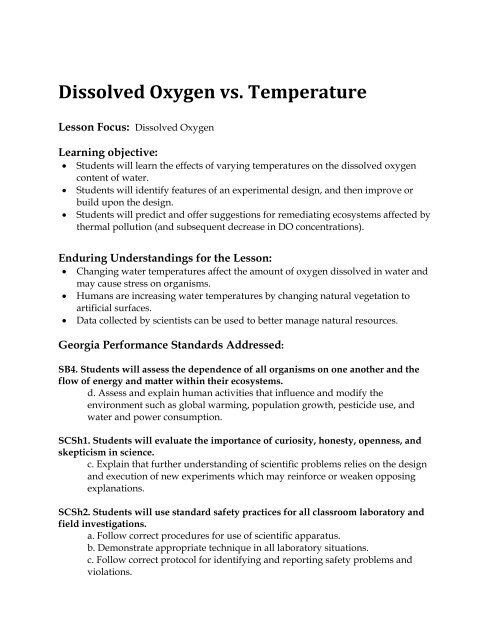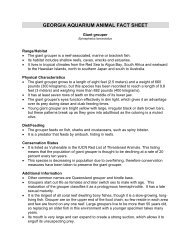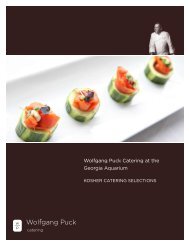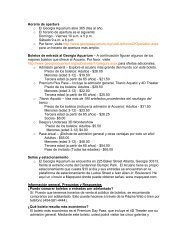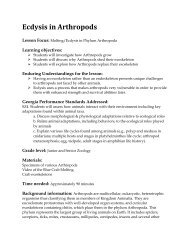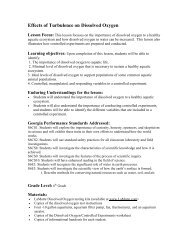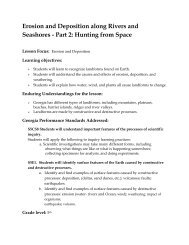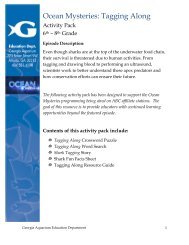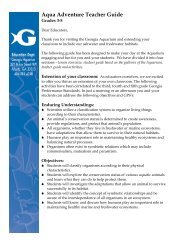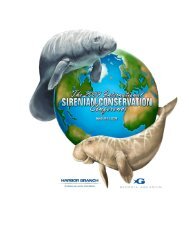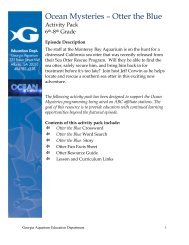Dissolved Oxygen vs. Temperature - Georgia Aquarium
Dissolved Oxygen vs. Temperature - Georgia Aquarium
Dissolved Oxygen vs. Temperature - Georgia Aquarium
You also want an ePaper? Increase the reach of your titles
YUMPU automatically turns print PDFs into web optimized ePapers that Google loves.
<strong>Dissolved</strong> <strong>Oxygen</strong> <strong>vs</strong>. <strong>Temperature</strong><br />
Lesson Focus: <strong>Dissolved</strong> <strong>Oxygen</strong><br />
Learning objective:<br />
• Students will learn the effects of varying temperatures on the dissolved oxygen<br />
content of water.<br />
• Students will identify features of an experimental design, and then improve or<br />
build upon the design.<br />
• Students will predict and offer suggestions for remediating ecosystems affected by<br />
thermal pollution (and subsequent decrease in DO concentrations).<br />
Enduring Understandings for the Lesson:<br />
• Changing water temperatures affect the amount of oxygen dissolved in water and<br />
may cause stress on organisms.<br />
• Humans are increasing water temperatures by changing natural vegetation to<br />
artificial surfaces.<br />
• Data collected by scientists can be used to better manage natural resources.<br />
<strong>Georgia</strong> Performance Standards Addressed:<br />
SB4. Students will assess the dependence of all organisms on one another and the<br />
flow of energy and matter within their ecosystems.<br />
d. Assess and explain human activities that influence and modify the<br />
environment such as global warming, population growth, pesticide use, and<br />
water and power consumption.<br />
SCSh1. Students will evaluate the importance of curiosity, honesty, openness, and<br />
skepticism in science.<br />
c. Explain that further understanding of scientific problems relies on the design<br />
and execution of new experiments which may reinforce or weaken opposing<br />
explanations.<br />
SCSh2. Students will use standard safety practices for all classroom laboratory and<br />
field investigations.<br />
a. Follow correct procedures for use of scientific apparatus.<br />
b. Demonstrate appropriate technique in all laboratory situations.<br />
c. Follow correct protocol for identifying and reporting safety problems and<br />
violations.
SCSh3. Students will identify and investigate problems scientifically.<br />
a. Suggest reasonable hypotheses for identified problems.<br />
b. Develop procedures for solving scientific problems.<br />
c. Collect, organize and record appropriate data.<br />
d. Graphically compare and analyze data points and/or summary statistics.<br />
e. Develop reasonable conclusions based on data collected.<br />
SCSh6. Students will communicate scientific investigations and information clearly.<br />
c. Use data as evidence to support scientific arguments and claims in written or<br />
oral presentations.<br />
d. Participate in group discussions of scientific investigation and current<br />
scientific issues.<br />
Grade level: 9 – 12th<br />
Materials: (materials needed for one group)<br />
- one LaMott <strong>Dissolved</strong> <strong>Oxygen</strong> Kit (or similar kit)<br />
- one Celsius thermometer<br />
- one 1000 mL Beaker<br />
- 1000 mL of distilled water<br />
- one aquarium air pump/aerator<br />
- one heating pad<br />
- one wall clock with a second hand<br />
- one wooden or plastic spoon.<br />
Time needed: 90 minutes<br />
Background information:<br />
Free molecular oxygen (O2) is necessary for most organisms to survive, and thrive. This<br />
is demonstrated by the role of oxygen in the process of respiration. Without free<br />
oxygen (O2) nearly all eukaryotic unicellular organisms and all multi-cellular organisms<br />
as we know them would not exist.<br />
Water is a requirement for all organisms (unicellular to multi-cellular) on earth. Within<br />
each cell, water is the medium in which the ions, compounds, and dissolved gases,<br />
including oxygen (O2) necessary for life are found. The proper regulation of water into<br />
and out of cells regardless of habitat – land or water (fresh or salt) is dependent on the<br />
cell’s ability manage salt concentration. Additionally, life found on land must adapt to<br />
potentially desiccating conditions such as aridity, wind, and heat.
<strong>Temperature</strong> affects how readily solutes dissolve in solvents. Typically, solids dissolve<br />
quicker in warmer than cooler solvents. The opposite holds true for most gases.<br />
Generally, as the temperature of a solvent increases, the solvent is less able to hold onto<br />
its dissolved gases. Mathematicians and scientists describe this as an inverse<br />
relationship: as one variable increases, the other decreases. Therefore, warmer water<br />
holds less dissolved oxygen than equivalent volumes of cooler water. Since oxygen<br />
needs vary by species, varying temperatures will dictate the health of a species, and the<br />
types of species present within an ecosystem.<br />
Humans have greatly affected the temperatures of natural water systems. Thermal<br />
pollution from power plant discharge, runoff from buildings, and road surfaces has<br />
resulted in storm water flowing into streams at significantly increased temperatures,<br />
especially in the summer months, than that of the stream. Consequently, as this<br />
warmer water enters the stream, the temperature quickly changes, reducing the amount<br />
of dissolve oxygen available. This can stress naturally occurring organisms in the<br />
ecosystem to the point of eliminating them, and can encourage new and often<br />
unwanted species to assume residence in the existing area.<br />
Learning Procedure:<br />
1. Divide the students in your class into groups of two or three (equipment<br />
dependent). Have each group gather material listed above.<br />
2. Explain to students that they will be conducting an experiment to test the effect<br />
of increasing temperature on the concentration of dissolved oxygen found in<br />
water. Have students discuss whether warm water or cool water holds more<br />
dissolved oxygen. Query them about their beliefs. Ask them if they have they<br />
considered the amount of life found in warm seas and cold seas Be sure<br />
students understand the difference between amount of life (as measured by<br />
biomass), and number of species. Generally, it is understood that cool, higher<br />
latitude seas contain fewer species, but greater biomass than warmer, equatorial<br />
seas. Actually, biomass is usually as great in cooler seas, even though they are<br />
often very murky, and sometimes opaque!<br />
3. Then, have students create a hypothesis addressing their belief about<br />
temperature (of water) and the amount of dissolved oxygen found in the water.<br />
A possible hypothesis is: “As the temperature of water is increased, then the<br />
amount of dissolved oxygen in the water will ______________________________.<br />
(Increase decrease Remain the same)”<br />
4. SETUP -Have students place the 1000 mL beaker on top of the heating pad(s).<br />
The heating pads should be in the “off” position. Students should fill the beaker<br />
with 1000 mL of distilled water, and properly setup an air pump/aerator (turned<br />
“on”). Allow one day to permit the surface agitation produced by the air<br />
pump/aerator to allow oxygen to dissolve into the distilled water establishing a<br />
baseline equilibrium concentration.
5. Begin the experiment. To ensure mixing, gently (but, thoroughly) stir the water<br />
with the spoon for one minute. Stirring will disrupt any thermocline (and<br />
thermocline-driven DO disparities) that might have occurred. Record the<br />
temperature of the water in the beaker at a mid-depth, and centered in the<br />
beaker. Then, using the directions accompanying the LaMott’s (or other)<br />
dissolved oxygen (DO), kit test and record the dissolved oxygen content of the<br />
water.<br />
6. Turn on the heating pad(s) for ten minutes. After ten minutes, gently stir the<br />
water, and then record the temperature and DO of the water (mid-depth, and<br />
laterally centered). Continue to record the temperature and DO content of the<br />
water at regular intervals as time permits.<br />
7. Have students create a graph of their results.<br />
8. As a class, discuss the following:<br />
• What effect could thermal pollution, and subsequent decrease in DO, have on<br />
an aquatic ecosystem such as a local stream, lake, pond, etc.<br />
• What are some sources of thermal pollution (runoff from hot asphalt<br />
roadways after a storm, power plants, hot roof tops, etc.)<br />
• What might be some methods or techniques to mitigate or eliminate sources<br />
of thermal pollution (retention ponds in parking lots, using porous pavers<br />
for parking lots, selecting light colors for roofs, planting trees, leaving trees in<br />
new developments)<br />
Evaluation:<br />
1. Graph – Did they properly complete the graph with temperature measured in<br />
degrees Celsius The temperature will be your independent variable represented<br />
on the x-axis, and DO will be dependent variable represented on the y-axis.<br />
2. In paragraph form, have students answer the following questions:<br />
• Have students evaluate the validity of their hypothesis.<br />
• Ask students for suggestions to improve the experimental design.<br />
• Have students suggest additional follow-up experiments.<br />
Extensions:<br />
1. Collect and test (temperature and DO concentration) at a local stream and/or<br />
from a variety of runoff sources including roadways, roofs/gutters, lawns,<br />
natural vegetation, etc. immediately after a rain event. Testing is best done<br />
immediately on site.<br />
2. Challenge students to identify sources of thermal pollution in their communities<br />
and develop and implement a program to help others understand the problems
and initiate discussion on how best to mitigate or better yet eliminate the<br />
problems<br />
3. Have students develop short radio and/or television reports to disseminate<br />
information about the issue for broadcast on local stations.<br />
4. Have students research animals that have been affected by thermal pollution and<br />
report back to class through a power-point presentation. (Manatees and<br />
American crocodiles in the southeast have become habituated to using warm<br />
water runoff from power plants to overwinter in places they normally would<br />
not.)<br />
Resources:<br />
‣ Adopt-A–Stream – www.georgiaadoptastream.org/home.html - for maps, listing<br />
of workshops, Educator Guide, and other resources.<br />
‣ EPA website at www.epa.gov/OWOW/watershed/ - for more information<br />
about watersheds and additional lessons and resources.<br />
‣ <strong>Georgia</strong> River Network – www.garivers.org - for fact sheets about the 14 major<br />
watersheds in <strong>Georgia</strong>.<br />
> National Oceanic and Atmospheric Administration (NOAA) –<br />
http://www.noaa.gov/ - for information of a general nature concerning earth<br />
systems, and the environment.<br />
> U.S. Geological Survey (USGS) - http://www.usgs.gov/ -for information about<br />
biology, geography, geology, geospatial, water, hazards, as well as other<br />
resources.<br />
Lesson developed by: Michael A. Pastirik, Lakeside High School<br />
This activity is a product of the Rivers to Reef Teacher Workshop sponsored by the <strong>Georgia</strong><br />
<strong>Aquarium</strong> and Gray’s Reef National Marine Sanctuary that the author participated in. For<br />
more information about this workshop, <strong>Georgia</strong> <strong>Aquarium</strong>, or NOAA Gray’s Reef National<br />
Marine Sanctuary, please visit our websites at www.georgiaaquarium.org or<br />
http://graysreef.noaa.gov/


